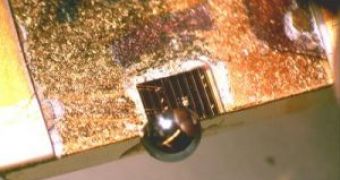The new breakthrough in laser technology comes from Harvard University researchers who have designed and demonstrated the first Terahertz coherent source using room-temperature electrically-pumped semiconductors. The terahertz laser sources commercially available today are based on nanotechnology fabrication techniques, while the new laser technology uses a semiconductor structure to emit radiation. The device is expected to become the new standard in T-ray technology and revolutionize most of the security screening applications, such as chemical sensing for example.
Until now, operating Terahertz lasers covering the 30 to 300 angstrom wavelengths proved to be an impossible task for most researchers, mostly because electrically pumped room-temperature and thermoelectrically-cooled semiconductor lasers were needed for the job. These particular devices require cryogenic cooling, which limits their use in everyday applications.
"By contrast, our device emits T-rays with several hundreds of nanowatts of power at room temperature and microwatts of power at temperatures easily achievable with commercially available thermoelectric coolers. Further, there is the potential of increasing the terahertz output power to milliwatt levels by optimizing the semiconductor nanostructure of the active region and by improving the extraction efficiency of the terahertz radiation", said Mikhail Belking, part of the researching team that created the revolutionary device.
The new laser design is based on a mid-infrared Quantum Cascade Laser, generating Terahertz radiation through a difference-frequency generation process at the 5 Terahertz. This particular frequency is the difference of the two emissions generated simultaneously by the QCL.
Mid-infrared QCL devices were invented at Bell Labs in 1994 by Frederico Capasso, also part of the research team that created the new device, can be operated at room temperature, present high optical powers and are widely used in chemical sensing and trace gas analysis. The laser is made out of ultra-thin atomic layers of semiconductor materials placed on top of each other, meaning it is variable and tunable and can be adjusted at different energy levels by modifying the semiconductor structure.
"Terahertz imaging and sensing is a very promising but relatively new technology that requires compact, portable and tunable sources to achieve widespread penetration. Our devices are an important first step in this direction. We believe our THz source has great development potential because the nanoscale material used was grown by Molecular Beam Epitaxy, a commercial and widely used thin film growth technique which 'spray paints' atoms on a surface one layer at a time", Capasso said.
Because Terahertz radiation penetrates materials such as paper, plastics and even clothing, it can be used to detect concealed weapons, chemical and biological agents or even material defects without even breaking the seal of a package or removing unnecessary parts to spot a fissure, for example.

 14 DAY TRIAL //
14 DAY TRIAL //